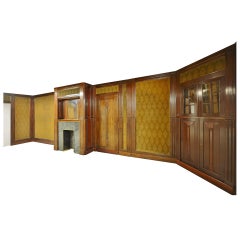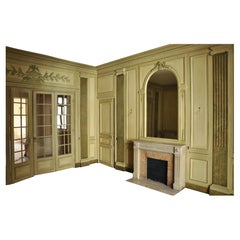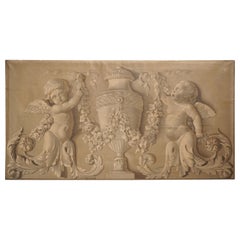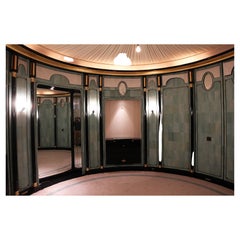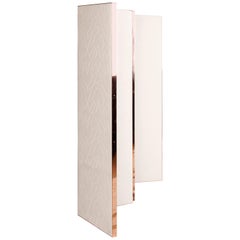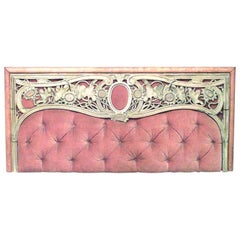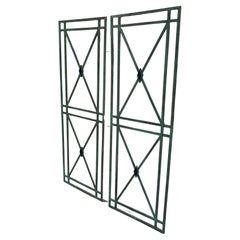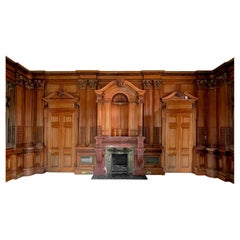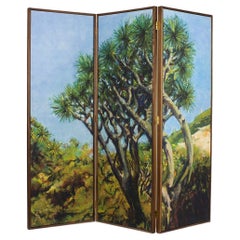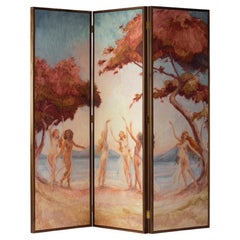Fabric Panelling
to
23
6
19
10
Height
to
Width
to
19
1
1
1
1
1
1
4
5
19
3
1
1
219
69
35
32
29
27
18
6
1
1
29
10
11
1
1
1
Material: Fabric
Mahogany and Fabric Panelled Room, Designed by Jac. van den Bosch
Located in Haarlem, Noord-Holland
A rare opportunity to acquire this exquisite panelled room with original wall fabric, circa 1912.
This room was designed by Jac. van den Bosch (1868-1948), the wall fabric was design...
Category
20th Century Dutch Fabric Panelling
Materials
Fabric, Mahogany
Louis XVI Style Panelling with Fireplace and a Marine Scene, Oil on Canvas
Located in SAINT-OUEN-SUR-SEINE, FR
This paneled room is composed of a stone fireplace, a large glass door with four leaves, a single door (both with their frame) and a large oil on canv...
Category
19th Century French Louis XVI Antique Fabric Panelling
Materials
Stone
Antique French Neoclassical Grisaille Overdoor Painting, Circa 1815
Located in Dallas, TX
Hand-painted in France, this handsome grisaille overdoor painting is from the neoclassical period, circa 1815. Grisaille is a monochromatic painting ...
Category
1810s French Neoclassical Antique Fabric Panelling
Materials
Canvas
Round Room with Shagreen Wallpaper
By Emilio Terry
Located in SAINT-OUEN-SUR-SEINE, FR
This round piece made at the end of the 20th century comes from a Parisian mansion. Its decoration is inspired by the work of the Franco-cuban decorator Emilio Terry (1890 -1869). Th...
Category
20th Century French Art Deco Fabric Panelling
Materials
Alpaca, Mirror, Beech, Plywood, Paper
Queen Heart Folding Screen by Royal Stranger
Located in Geneve, CH
Queen heart folding screen by Royal Stranger
Dimensions: 190 x 200 x 4 cm
Materials: Pearl royal velvet upholstery framed with stainless steel coated in copper.
The Queen heart ...
Category
2010s Portuguese Modern Fabric Panelling
Materials
Brass
$15,935 / item
Art Nouveau Pink Velvet Wall Panel
Located in Queens, NY
Art Nouveau stripped wall panel with pink velvet inset backing and carved floral filigree design.
Category
Early 20th Century Art Nouveau Fabric Panelling
Materials
Velvet, Wood
Set of 4 Large French 19th Century Oil on Canvas Wall Panels Trumeau Paintings
Located in Manhasset, NY
French 19th Century, Oil on Canvas, Wall Panels or Trumeau Paintings
Set of 4 large 19th century oil on canvas wall panels Trumeau paintings. These finely painted panels are simply ...
Category
Early 1900s French Belle Époque Antique Fabric Panelling
Materials
Canvas, Wood
Opto Folding Screen 4 Colors Lacquered by Colé Italia
Located in Geneve, CH
Opto Folding screen 4 colors Lacquered by Colé Italia with Lorenz + Kaz
Dimensions: H 200, W 300, D 4 cm
Materials: Laser-cut metal panels inside the frame, black anthracite or lacqu...
Category
2010s Italian Modern Fabric Panelling
Materials
Wool, Upholstery, Wood
$12,388 / item
Opto 1/2 Folding Screen, Colors Lacquered by Colé Italia
Located in Geneve, CH
Opto 1/2 folding screen, colors Lacquered by Colé Italia with Lorenz + Kaz
Dimensions: H 200, W 300, D 4 cm
Materials: Laser-cut metal panels inside th...
Category
2010s Italian Modern Fabric Panelling
Materials
Wool, Upholstery, Wood
Telo Screen by Colé Italia
Located in Geneve, CH
Telo screen by Colé Italia with Lorenz + Kaz
Dimensions: H 220, W 124, D 40 cm
Materials: Partition screen in solid oak; round foot in red lacquered MDF
...
Category
2010s Italian Modern Fabric Panelling
Materials
Wool, Upholstery, Wood
$2,096 / item
Kazimir Screen, Type B, Floral Coating in Jersey by Colé Italia
Located in Geneve, CH
Kazimir Screen, Type B, Floral coating in Jersey by Colé Italia with Julia Douza
Dimensions: H.150 D.133 W.40 cm
Materials: Partition screen with jers...
Category
2010s Italian Modern Fabric Panelling
Materials
Steel
Kazimir Screen, Type B, Abstract Coating in Silk by Colé Italia
Located in Geneve, CH
Kazimir screen, type B, geometric coating in silk by Colé Italia with Julia Douza.
Dimensions: H.150 D.133 W.40 cm.
Materials: Partition screen with jersey fabric coating with fant...
Category
2010s Italian Modern Fabric Panelling
Materials
Steel
Kazimir Screen, Type B, Floral Coating in Silk by Colé Italia
Located in Geneve, CH
Kazimir Screen, Type B, floral coating in silk by Colé Italia with Julia Douza
Dimensions: H.150 D.133 W.40 cm
Materials: Partition screen with jersey...
Category
2010s Italian Modern Fabric Panelling
Materials
Steel
Opto 1/2 Folding Screen Black Lacquered by Colé Italia
Located in Geneve, CH
Opto 1/2 folding screen black lacquered by Colé Italia with Lorenz + Kaz
Dimensions: H 200, W 150, D 4 cm
Materials: Laser-cut metal pa...
Category
2010s Italian Modern Fabric Panelling
Materials
Wool, Upholstery, Wood
Kazimir Screen, Type C, Abstract Coating in Silk by Colé Italia
Located in Geneve, CH
Kazimir screen, Type C, geometric coating in silk by Colé Italia.
Dimensions: H.159, D.116, W.40 cm.
Materials: Partition screen with jersey fabric co...
Category
2010s Italian Modern Fabric Panelling
Materials
Steel
Kazimir Screen, Type B, Abstract Coating in Jersey by Colé Italia
Located in Geneve, CH
Kazimir screen, type B, geometric coating in Jersey by Colé Italia with Julia Douza
Dimensions: H.150 D.133 W.40 cm
Materials: Partition screen with j...
Category
2010s Italian Modern Fabric Panelling
Materials
Steel
Kazimir Screen, Type A, Abstract Coating in Jersey by Colé Italia
Located in Geneve, CH
Kazimir Screen, Type A, Abstract Coating in Jersey by Colé Italia with Julia Douza
Dimensions: H.180 D.123 W.40 cm
Materials: Partition screen with jersey fabric coating with fanta...
Category
2010s Italian Modern Fabric Panelling
Materials
Steel
Kazimir Screen, Type C, Abstract Coating in Jersey by Colé Italia
Located in Geneve, CH
Kazimir screen, type C, geometric coating in Jersey by Colé Italia with Julia Douza
Dimensions: H.159 D.116 W.40 cm.
Materials: Partition screen with ...
Category
2010s Italian Modern Fabric Panelling
Materials
Steel
Kazimir Screen, Type C, Floral Coating in Silk by Colé Italia
Located in Geneve, CH
Kazimir screen, Type C, Floral coating in silk by Colé Italia with Julia Douza
Dimensions: H.159 D.116 W.40 cm
Materials: Partition screen with jersey fabric coating with fantasy p...
Category
2010s Italian Modern Fabric Panelling
Materials
Steel
Early 20th century French Glass and Fabric Folding Screen, 1920s
Located in LEGNY, FR
Add a touch of elegance and vintage charm to your interior with this stunning three-panel screen.
Perfect for dividing spaces in a living room, bedroom, or office, creating a cozy no...
Category
1920s French Vintage Fabric Panelling
Materials
Fabric, Glass, Wood
Important Monumental Italian Church Altar Frontal Antependium
Located in Forney, TX
A magnificent Italian church antependium altar frontal, acquired from the estate of the iconic American oil tycoon, T. Boone Pickens. The last photo show...
Category
19th Century Antique Fabric Panelling
Materials
Fabric, Wood
Very Fine Late 17th Century Allegorical Flemish Renaissance Baroque Tapestry
Located in Miami, FL
A very fine late 17th century allegorical Flemish Renaissance Baroque tapestry. Cavaliers
Frame measurements: 1.5in.
Category
Late 17th Century European Baroque Antique Fabric Panelling
Materials
Fabric
19th Century French 4-Panel Wallpaper Mounted on Canvas Folding Screen
Located in Atlanta, GA
19th century French 4-Panel Wallpaper mounted on Canvas Folding Screen featuring Canal Scene.
Category
19th Century French Antique Fabric Panelling
Materials
Canvas
Set of 3, Kazimir Screens, Abstract Coating in Silk by Colé Italia
Located in Geneve, CH
Set of 3, Kazimir screens, Abstract coating in silk by Colé Italia with Julia Douza
Dimensions: H 159, D116, W40 cm.
Materials: Partition screen with jersey fabric coating with fantasy prints and a steel shaped rusted support;
the structure is composed with 2 with frames in steel or in wood upholstered.
Also available: different coatings, Jersey and Silk Upholstery, Type A, B, C, Custom Printing.
The shapes and decor of these three screens...
Category
2010s Italian Modern Fabric Panelling
Materials
Steel
Kazimir Screen, Type C, Floral Coating in Jersey by Colé Italia
Located in Geneve, CH
Kazimir Screen, Type C, floral coating in Jersey by Colé Italia with Julia Douza.
Dimensions: H.159, D.116, W.40 cm.
Materials: Partition screen with ...
Category
2010s Italian Modern Fabric Panelling
Materials
Steel
Kazimir Screen, Type A, Abstract Coating in Silk by Colé Italia
Located in Geneve, CH
Kazimir Screen, type A, abstract coating in silk by Colé Italia with Julia Douza
Dimensions: H.180, D.123, W.40 cm
Materials: Partition screen with je...
Category
2010s Italian Modern Fabric Panelling
Materials
Steel
Set of 3, Kazimir Screens, Floral Coating in Silk by Colé Italia
Located in Geneve, CH
Set of 3, Kazimir Screens, floral coating in Silk by Colé Italia with Julia Douza
Dimensions: H.159 D.116 W.40 cm
Materials: Partition screen with jersey fabric coating with fantas...
Category
2010s Italian Modern Fabric Panelling
Materials
Steel
Set of 3, Kazimir Screens, Abstract Coating in Jersey by Colé Italia
Located in Geneve, CH
Set of 3, Kazimir screens, abstract coating in Jersey by Colé Italia with Julia Douza
Dimensions: H.159 D.116 W.40 cm
Materials: Partition screen with jersey fabric coating with fa...
Category
2010s Italian Modern Fabric Panelling
Materials
Steel
Set of 3, Kazimir Screens, Floral Coating in Jersey by Colé Italia
Located in Geneve, CH
Set of 3, Kazimir screens, floral coating in Jersey by Colé Italia with Julia Douza
Dimensions: H.159 D.116 W.40 cm
Materials: Partition screen with j...
Category
2010s Italian Modern Fabric Panelling
Materials
Steel
Related Items
French Directoire Style Bronze Wall Panels
Located in Sherborne, GB
French Directoire style bronze wall mounted panels, the classic X-frame panels with central diamond made from molten enamel.
So stylish, these panels can be wall mounted to give ...
Category
Late 20th Century French Directoire Fabric Panelling
Materials
Bronze
George Trollope & Sons fireplace & room, Paris Exhibition 1878 Gold Medal Winner
Located in London, GB
George Trollope and Sons. Exhibited at the Paris Universal Exhibition in 1878 winning a Gold Medal for Excellence.
The set forms the four sides of a complete panelled room that was exhibited as a boudoir room or petit salon at the Paris Exhibition 1878 .
The main feature and centrepiece of this boudoir room is the Rosso Antico marble fireplace surmounted by an open display niche carved in cedar wood.
Each side of the room is composed of various panels and are as follows:
One side with a grand Rosso Antico marble fireplace flanked by two doorways.
One side with French doors originally opening onto a balcony, flanked by two large bookshelves.
One side with a window flanked by two mirrors. The opposite side with three large mirrors.
The complete room measures:
21 ft / 6.4 m wide, 17 ft / 5.18 m deep, and 12 ft / 3.65 m high.
It could also be used in a number of different combinations to suit various room layouts. The mirrors could be replaced with windows or further bookcases.
Each side is decorated with various sizes of finely carved panels and holds ornate Corinthian style columns surmounted with cherubim's on the capitals. Three cherubs are formed at the top of each corner with three columns, at the column bases there are circular carved pedestals to display statues.
Published & illustrated in the ‘Illustrated Catalogue of the Paris International Exhibition’.
The main part of this room, the Rosso Antico marble fireplace is surmounted by a large open display niche carved in cedar wood are illustrated with a line drawing in the Paris Universal Exhibition catalogue on page 209. The whereabouts of the seminaked caryatids and the marble bust of Alexander Pope are unknown. The bust of Alexander Pope was copied from the original one in Westminster Abbey, London.
The Corinthian columns now flanking the niche above the fireplace are also in cedar wood having the identical carved fluting to the rest of the room and were made to replace the caryatid figures. Those Corinthian columns are period to the room and can only have been made shortly after it arrived back to London and before it was reassembled and fitted into the house built by George Trollope and Sons in the 1880's, and where we removed it all from.
George Trollope made clever use of Alexander Pope's early 18th-century poetical successes in Great Britain and France by using ‘The Rape of Lock’, a mock-heroic narrative poem Pope wrote in 1712 about Petre who cut off a lock of Arabella’s hair without her permission, as the theme of the boudoir room or petit salon at the 1878 Paris Exhibition.
In the original exhibition display of the room set, tapestries depicting the Rape of Lock were hung where the mirrors are now positioned.
Alexander Pope's The Rape of the Lock is a humorous indictment of the vanities and idleness of 18th-century high society. Basing his poem on an actual incident among two families of his acquaintance, Pope intended his verses to quench hot tempers and to encourage his friends to laugh at their own foolishness.
The poem is an outstanding example in the English language of the genre of mock-epic. The 'epic' was considered one of the most serious of literary forms; it had been applied, in the classical period, to the trivialities of love and war. Pope’s mock-epic is not to mock the form itself, but to mock his society in its very failure to rise to epic standards, exposing its pettiness by casting it against the grandeur of the traditional epic subjects and the bravery and fortitude of epic heroes: Pope’s mock-heroic treatment in The Rape of the Lock underlines the ridiculousness of a society in which values have lost all proportion, and the trivial is handled with the gravity and solemnity that ought to be accorded to truly important issues. The 18th-century society in this poem fails to distinguish between things that are important and things that are not. The poem mocks the men it portrays by representing them as unworthy of a heroic culture. Therefore the mock-epic follows the epic in that its main concerns are serious and moral. The point that the theme must now be satirical rather than earnest is symptomatic of how far the culture has fallen.
Retaining the original exhibition label
The back of the panelling still retains two original labels printed with the 'Union Jack' and printed adjacent to it, 'The Secretary Royal British Commission for the Universal Exhibition 1878 Champ de Mars Paris'.
Adjacent to that and below, printed and written in ink vertically:
Exhibitor: (and signed in ink) George Trollope & Sons.
Address: (written in ink) Halkin Street West. London.
Allotment in Block: (written in ink) a2. In the printed floor plan 'a2 square' is in the very first line to the right of the floor plan and handwritten in ink with a 'diamond shape' also written with '101' within it. This pin points where George Trollope's stand was located.
With thousands of items being displayed at the Exhibition, this label would have been the floor plan for the craftsmen, so they knew the correct place to install the boudoir room or petit salon.
The firm continued expanding house building and interior decoration side of the business and by 1849 was also trading as an estate agency, letting and controlling property for the Grosvenor Estates. A separate branch of cabinet-makers, bearing the family name, was opened at West Halkin Street, London. becoming known as 'The Museum of Decorative Arts' (looked after by George Robinson). Here Trollope and Sons also sold high-class antique furniture made by other makers. In 1851, the firm became formally known as George Trollope and Sons. West Halkin Street, London. The address was recorded in the listing for the firm in The Furniture Gazette Directory, 1876 & 1877.
Period Press Coverage & Art Critic Review.
everal newspapers also thoroughly describe George Trollope and Son's stand including the different tapestries that were hung where the mirrors are now, illustrating the poem 'The Rape of Lock', by Alexander Pope.
Marius Vachon, a French Art Critic and journalist, who wrote for the journal ‘La France’ published an extensive review of the Trollope and Sons stand in a book called Les Merveilles de l'Exposition de 1878 (The Wonders of the 1878 Exhibition).
Note: In the World Fairs translation it states door frame, Marius Vachon had originally written ‘chambranle’ in French, 'chambranle' loosely translates to a frame around something, and should read in its correct context: ‘fireplace in rosso antico’.
We have taken the extract below written by Marius Vachon in its translated form from: Les Merveilles de l'Exposition de 1878, (The Wonders of the 1878 Exhibition). This puts into perspective the importance of this fine quality room interior when he viewed it at the exhibition in 1878:
Marius Vachon: English furniture is very curious to observe; irreproachable from the point of view of execution, the furniture of our neighbours always reaches the last degree of respectability and comfort. One thing to be noticed is that for large pieces of furniture, the English upholsterer is transformed into a sort of architect; everything he makes takes on a monumental aspect.
The first object that catches the eye when one enters the furniture class is the beautiful boudoir-salon exhibited by Mr. Trollope. The boudoir (or petit salon), of carved cedar wood, is an attempt to reproduce the style which prevailed in England during the first decade of Queen Anne's reign, and all the details have been studied, but not copied, from examples of decorative work of the time. The fireplace is in "rosso antico" movement, and the ceiling is in portable plaster. The panels painted on canvas represent scenes from the heroic-comic poem "The Abduction of the Hairpin," (The Rape of Lock) written by Alexander Pope in 1712, the eighth year of Queen Anne's reign, in which the customs and mores of the time are satirized in a pleasing manner.
The apotheosis of the Loop and its sidereal transformations will form the decoration of the ceiling. In these illustrations of Pope's charming poem, the costumes and accessories have been taken from models of the time; and the bust of the poet, copied from his tomb in Westminster Abbey, occupies the niche in the centre of the mantelpiece.
M. Marius Vachon, the period writer of the above continues with:
Now we shall mention at random the magnificent dining table of Messrs. Johnston and Co., their oak mantelpiece, their boudoir table; Mr. Watt's drawing-room mantelpiece stepped in the old style and imitating the Japanese; Mr. James Shoolbred's great
The Decorative Arts Society on Trollope and Sons
The boudoir or petit salon is mentioned again in the Decorative Arts Society:
Trollope did not exhibit such highly rated objects at the 1878 Paris Exhibition as at previous exhibitions; items included a large mirror frame carved in limewood in Renaissance style and a satinwood cabinet in Adam revival style, with a similar armchair (illus. Meyer (2006), p. 242) and probably two rooms; one was a boudoir in cedar wood in Queen Anne style and the other was a boudoir decorated by the firm in the theme of Pope’s The Rape of Lock.
In the above extract, it is quite clear that the two rooms mentioned are in fact the very same room, because the fireplace and niche are illustrated in The Paris Universal Exhibition catalogue on page 209 and Marius Vachon describes the rest of the room set in the above…
Trollope and Sons exhibition pieces listed and described by Meyer in an article he wrote for: The Decorative Arts Society 1850 to present, Journal 25 in 2001., where he points out the importance of George Trollope and Sons and mentions a table by Trollope exhibited at the 1867 exhibition that sold for £40,000 in 1996. He also mentions a cabinet exhibited by Trollope at the International Exhibition of 1862 that sold at Sotheby's in 1997 for £150,000.
Interest was not as strong in the 1990's as it is today for rare exhibition pieces, high quality items were abundant back then, it was a golden era when the most beautiful works of art just kept coming onto the market. But there are exceptions as in this instance, when a unique, gold medal-winning exhibition work of art comes onto the market for the very first time.
Meyer continued researching and writing about the great exhibitions and released his book in 2006, 'The Great Exhibitions, London, New York, Paris and Philadelphia 1851- 1900, where he mentions only in passing, The Boudoir Room or Petite Salon exhibited by Trollope, he even states that an image was not reproduced and that Trollope's exhibits in 1878 were not up to the quality and class of the items Trollope exhibited in London in 1862 and Paris in 1868. This is probably because Meyer didn't know of the line drawing illustrating the Roso Antico Fireplace, Niche and Panelling reproduced in The Illustrated Catalogue of the Paris International Exhibition 1878 shown in the above which Geering recently uncovered.
John Meyer continues in the DAS journal:
Undoubtedly they (Trollope) are a firm worthy of further research as they were right at the forefront of the furniture business in London from 1860 to 1880.
Our research shows that the Petite Boudoir was awarded the gold medal for excellence in 1878 (see Journal La Liberté 23-10-1878 with the list of all medals attributed), something George Trollope and Sons did not achieve at the London 1862 and the Paris 1867 exhibitions. Jonathan Meyer joined Bonham's in 1977. He was Director at Sotheby's in charge of 19th Century Furniture from 1994 to June 2007. He was also chairman of the Fine Arts Faculty for The Royal Institute of Chartered Surveyors.
In the original description from the article in Les Merveilles de l’exposition de 1878, M. Marius Vachon states:
The first object that catches the eye when one enters the (English) furniture class is the beautiful boudoir-salon exhibited by Mr. Trollope.
Suggesting, it was in his opinion the very best on display in the English section, and being awarded the gold medal for excellence can only add weight to this.
Adjacent to the original label that was printed by The Secretary - Royal British Commission for the Universal Exhibition 1878 in stencil ‘TO BE KEPT’, i.e. ‘to be returned’. This confirms why it came back to London. We removed the Boudoir Room or Petite Salon from a Trollope house, part of a grand high-class housing estate in London which around the time of the exhibition Trollope and Sons were in the process of building, and where the room set was installed directly after it returned from the exhibition in 1878 until now.
Worthy of note is the machines that did the carving for the Boudoir Room or Petite Salon and also did all of the decorative carving (most of which was linenfold carving) for the Houses of Parliament, London.
This machine, the engraving and description of which we copy from Engineering, was specially designed by its inventor, Mr. Jordan, for assisting in the production of the vast amount of carved decorations required for the walls and ceilings of the Houses of Parliament, London, and it was so employed during the entire progress of the work. The late Sir Charles Barry was so well satisfied with it, that he frequently declared it would have been impossible to have accomplished the work without it. The Department of Woods and Forests employed five of the machines at the Government Works, Thames Bank, for several years; and the machines have now passed into the hands of Messrs. George Trollope and Son, and are still used in the same building.
They also exhibited the new technique of xylatechnography and sgraffito, methods of impressing coloured design into soft wood and engraving veneer to reveal the base wood.
The newspaper, La Liberte October, 23rd 1878 listing the medal winners of the Paris 1878 exhibition. Third column, ''GROUPE III MOBILIER ET ACCESSOIRES'', (GROUP III FURNITURE AND ACCESSORIES). Medailles d'or. (Gold Medals) where G Trollope et fils (G Trollope and Sons...
Category
1870s Antique Fabric Panelling
Materials
Marble
$5,755,766
H 203.94 in W 251.97 in D 143.7 in
Folding Screen Room Divider in Solid Mahogany
Located in Mexico City, CDMX
We offer this folding screen made in solid frames of mahogany wood with brass details, circa 1950.
Category
1950s Mexican Mid-Century Modern Vintage Fabric Panelling
Materials
Mahogany
Original Paint 18th Century French Panel
Located in Chicago, IL
Original hand-carved 18th century French original paint panel just removed from a French chateau. A warm complimentary bluish putty gray finish highlights this fine architectural fra...
Category
18th Century and Earlier French Antique Fabric Panelling
Materials
Wood, Paint
Pair of Antique French Shutter in Old Crumbly Paint From a Chateau in Brittany
Located in Chicago, IL
Antique pair of French shutters in very old paint removed a long time ago from a chateau located in Brittany.
**Width provided is for the wider shutte...
Category
1880s French Country Antique Fabric Panelling
Materials
Wood, Paint
$450 / set
H 119 in W 11.38 in D 1.75 in
Asian Polychrome Coromandel Black Lacquer Enamel Eight-Panel Court Floor Screen
Located in Germantown, MD
Chinese Polychrome Coromandel Black Lacquer Eight-Panel Court Screen. Comprised of 8 lacquered coromandel panels, this Chinese folding screen is intri...
Category
Late 20th Century Chinese Chinoiserie Fabric Panelling
Materials
Enamel
$7,900
H 82 in W 144 in D 1 in
Pair of 18th Century Hand Carved Panels
Located in High Point, NC
Pair of 18th century hand carved panels. They have hand carved banding surrounding raised panels with hand carved designs, including florals, vines, and carved transom like patterns ...
Category
18th Century English Georgian Antique Fabric Panelling
Materials
Oak
Outstanding Set of 3 16th Century Spanish Ceiling Panels, Beams
Located in Round Top, TX
An outstanding and exceptional set of 3 16th century ceiling panels - beams from Barcelona. Hand hewn solid wood panels beautifully painted. Fabulous architectural elements to incorp...
Category
16th Century Spanish Antique Fabric Panelling
Materials
Wood
$8,950 / set
H 10 in W 92.5 in D 1.5 in
Art Nouveau Italian Brass Double Bed, Early 1900s
Located in Puglia, Puglia
Large Italian double bed from the early 20th century. Fabulous quality object and gilded brass decoration. Bed decorated with plaques depicting female characters and neoclassical che...
Category
Early 20th Century Italian Art Nouveau Fabric Panelling
Materials
Brass
$4,612 Sale Price
30% Off
H 72.05 in W 63 in D 89.77 in
Gallé Émile French Art Nouveau Nightstand
By Émile Gallé
Located in Prato, Tuscany
We kindly ask that you read the entire description, as we strive to provide detailed technical and historical information to guarantee the authenticity of our items. This exquisite n...
Category
Late 19th Century French Art Nouveau Antique Fabric Panelling
Materials
Maple, Walnut
Double Sided Coromandel Chinoiserie Lacquer Five-Panel Screen, Paravent, 1890s
By Jean Dunand
Located in Biebergemund, Hessen
Exceptional double sided Chinoiserie hand-painted Coromandel screen, with a continuous scene over the panels. One side depicts a scene of the Forbidden City, and the other side shows...
Category
Mid-19th Century French Chinoiserie Antique Fabric Panelling
Materials
Wood, Hardwood
$11,981
H 74 in W 107 in D 1 in
Large 8-Panel Coromandel Screen
Located in Stamford, CT
A grand eight panel Coromandel screen. The screen has mostly a gilt background with a few architectural structures and figures. A very good looking screen.
Category
1950s Asian Vintage Fabric Panelling
Materials
Wood
Previously Available Items
Luxury Screen Room Divider Linen Walnut or Oak Green Garden Artwork
Located in Paris, FR
Luxury screen, choose a walnut or oak frame. Simple, functional and elegant, The Floating Screen is a premier design unique. It features original oil on...
Category
2010s English Fabric Panelling
Materials
Cotton, Linen, Walnut, Oak
Screen Room Divider Linen Walnut Nymphs Artwork
Located in Paris, FR
Simple, functional and elegant, The Floating Screen is a premier design unique. It features original oil on canvas artworks, digitally printed onto loca...
Category
2010s English Fabric Panelling
Materials
Cotton, Linen, Walnut
Phillip Jeffries Manila Hemp Grasscloth Wallpaper French Gray, 3444 Graphite
Located in Brooklyn, NY
Phillip Jeffries Manila Hemp Grasscloth wallpaper French gray - 3444 Graphite; 40th Anniversary Limited Edition. MSRP 99.99 per yard (800 ...
Category
2010s Japanese Modern Fabric Panelling
Materials
Grasscloth, Paper
Monumental Antique Italian Religious Altar Frontal Tapestry Panel
Located in Forney, TX
An impressive Italian church altar frontal panel, aquired from the estate of the iconic American oil tycoon, T. Boone Pickens. The last photo shows a sec...
Category
Early 20th Century Fabric Panelling
Materials
Fabric, Velvet, Wood
N.3 Antique Paintings Classical Architectural Ruins, Canvas, Wood Frame, '700
Located in Cuneo, Italy (CN)
Set of 3 ancient paintings depicting classical architectural ruins, painted on canvas with a molurate wood frame and moved in the upper part, built and hand painted, it was probably an ancient booth of an elegant room in a noble palace, in the eighteenth century, for Italian palace, measures each cm W 69 x H 194 x D 4.
Ideal for furnishing, decorating a classy wall, as a chic room divider...
Category
18th Century Italian Antique Fabric Panelling
Materials
Canvas, Wood
H 76.38 in W 82.68 in D 1.19 in
N.3 Antique Paintings Classical Architectural Ruins, Canvas, Wood Frame, '700
Located in Cuneo, Italy (CN)
Set of 3 ancient paintings depicting classical architectural ruins, painted on canvas with a molurate wood frame and moved in the upper part, built and hand painted, it was probably an ancient booth of an elegant room in a noble palace, in the eighteenth century, for Italian palace, measures each cm W 69 x H 194 x D 4.
Ideal for furnishing, decorating a classy wall, as a chic room divider...
Category
18th Century Italian Antique Fabric Panelling
Materials
Canvas, Wood
H 76.38 in W 82.68 in D 1.19 in
Italian Vintage Fabric and Wood Abstract Door or Panel
Located in Milano, IT
Vintage Italian door or panel taken over from a private home. The door is circa 1950 and has a very eclectic and unique element: an abstract pain...
Category
1950s Italian Mid-Century Modern Vintage Fabric Panelling
Materials
Fabric, Wood
Antique Painting, Ceiling, on Canvas, 1700, Italy
Located in Cuneo, Italy (CN)
Large ancient painting, used and designed as a ceiling, hand painted on canvas, behind it has a wooden frame that supports the canvas. Motif with hexagons and central flowers, yellow...
Category
1770s Italian Antique Fabric Panelling
Materials
Canvas
Antique Ceiling Painted on Canvas, Wooden Frames, Arts and Muse, Late 1800 Italy
Located in Cuneo, Italy (CN)
Ancient hand painted ceiling on canvas with supporting frames in white lacquered wood, depicted in the center we have the inspiring muse, for the Arts depicted in the corners and int...
Category
Late 19th Century Italian Antique Fabric Panelling
Materials
Canvas
H 129.93 in W 216.54 in D 3.94 in
Phillip Jeffries Soho Hemp Hudson Haze Handmade Natural Wallpaper
Located in Brooklyn, NY
Phillip Jeffries Soho Hemp Hudson Haze handmade natural wallpaper. 36" W. Sold by 8 yard bolt. MSRP per yard: 78 USD (624 per bolt). Lovely color, som...
Category
Late 20th Century Japanese Modern Fabric Panelling
Materials
Grasscloth
Phillip Jeffries Seaside Linen Breeze Artisanal Wallpaper Tailored Textiles 5553
Located in Brooklyn, NY
Phillip Jeffries seaside linen breeze artisanal wallpaper tailored textiles 5553 trade only. MSRP is 129 dollars per yard. Listing is for one bolt of 12 yards (MSRP 1559 USD).
Category
Late 20th Century Japanese Modern Fabric Panelling
Materials
Linen
H 1 in W 432 in D 36 in
Set of Four 19th Century Chinese Lattice Scholars Panels
Located in Chicago, IL
The grand height and exquisite decorations make this set of four 19th century lattice panels a truly rare find. Likely the once courtyard doors of a fine Qing dynasty home in souther...
Category
Mid-19th Century Chinese Qing Antique Fabric Panelling
Materials
Fabric, Walnut
Recently Viewed
View AllMore Ways To Browse
Nena Claiborne
William Hugh Ferguson
Vince Camuto
Animal Door Handle
Antigua Guatemala
Antique American Stoneware Pottery
Antique Baccarat Decanter
Antique Bank Clock
Antique Beer Mugs
Antique Chawan
Antique Chinese Jade Rings
Antique Chinese Painting On Silk Panel
Antique Crystal Liquor Bottles
Antique Enamel Pill Box
Antique German Porcelain Brands
Antique Hamilton Cabinet
Antique Hand Stitched Wall Hanging
Antique Haviland Plates
